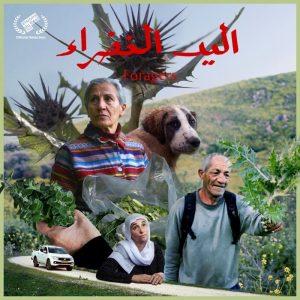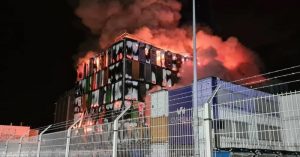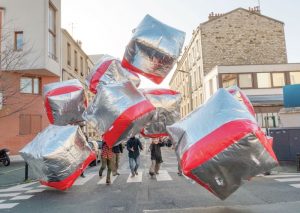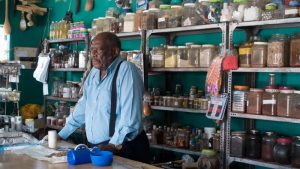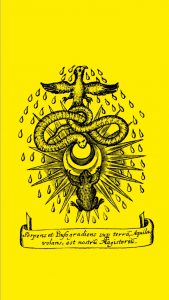Previously: Daimlerstrasse 38 or How to get a fox to shoot portrait of itself.
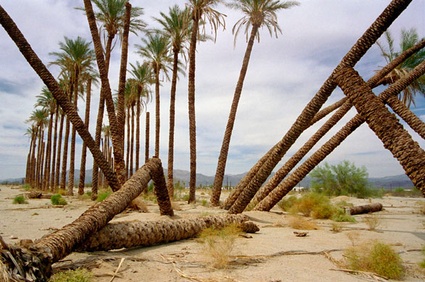 From the photo archive of the Centre for Land Use Interpretation, 1977. Photograph: CLUI archive
From the photo archive of the Centre for Land Use Interpretation, 1977. Photograph: CLUI archive
Radical Nature – Art and Architecture for a Changing Planet 1969-2009, an exhibition that opened a few days ago at the Barbican in London, brings together Land Art, environmental activism, experimental architecture and utopianism.
Artists and architects have always been moved and inspired by the beauty and mysteries of nature. Since the 1960s and even more unreservedly over the last five years, the increasingly evident degradation of the natural world and the effects of climate change have brought a new urgency to their responses.
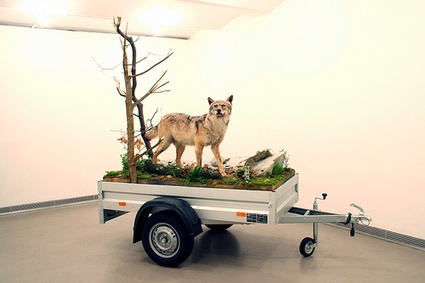 Mark Dion Mobile Wilderness Unit, Wolf, 2006. Courtesy Georg Kargl Fine Arts, Vienna. Photo: Lisa Rastl
Mark Dion Mobile Wilderness Unit, Wolf, 2006. Courtesy Georg Kargl Fine Arts, Vienna. Photo: Lisa Rastl
There is sincere commitment in artists’ efforts to raises consciences about the eco-drama our planet is going through… even if sometimes, while visiting artshows on a similar topic, i’ve found myself in front of art works or events that smelled a bit too pungently of opportunism. But if those artworks help us change the world that’s a good thing, right? My answer is “yes of course but how can i avoid being cynical?” As long as these artworks do not step out of museums and galleries most people hardly ever visit (i’m not talking about you and me but about my old friends, most of whom have no time nor inclination to follow the visual art scene), i fear that the impact of their work might be somewhat limited. Besides, setting up a contemporary art exhibition, whether its theme is eco-awareness or Bronze Age jewellery, is everything but a ‘sustainable’ activity. Laudable exceptions, however, are slowly emerging.
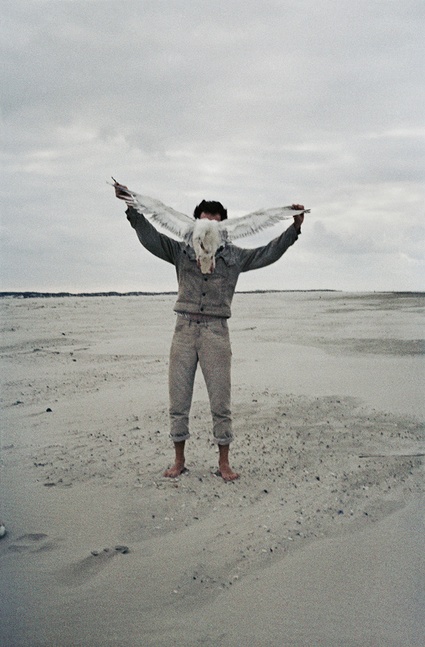 Lothar Baumgarten. Albatross,1968. Courtesy Marian Goodman Gallery, New York and Paris
Lothar Baumgarten. Albatross,1968. Courtesy Marian Goodman Gallery, New York and Paris
Right! That didn’t prevent me from enjoying Radical Nature. Unlike the many shows i’ve seen over the past 2 years on the exact same topic, this one is more than the sum of its parts. The pieces found on the first floor are mostly flashy, easy to love artworks. The most thought-provoking pieces occupy the gallery upstairs. Many of them are remnants of performances, photos and videos of actions, models of projects and other paraphernalia.
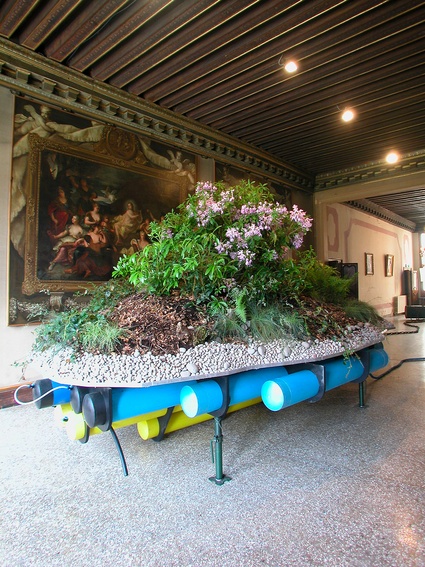 Simon Starling. Island for Weeds, 2003. Courtesy the artist and the Modern Institute/Toby Webster Ltd, Glasgow. Photo: Jeremy Hardman-Jones, c/o Scottish Arts Council
Simon Starling. Island for Weeds, 2003. Courtesy the artist and the Modern Institute/Toby Webster Ltd, Glasgow. Photo: Jeremy Hardman-Jones, c/o Scottish Arts Council
Back in 1999, Simon Starling was working on an artwork in Scotland when he learnt that rhododendrons were to be uprooted and destroyed in the country. Considered weeds in the UK, the plants were due to be removed by government agencies from an environmentally “pure” zone of native vegetation and destroyed. Starling took seven rhododendrons and drove all the way from Northern Scotland to southern Spain, reversing the introduction of these plants to England in 1763 by a Swedish botanist. The work, called Rescued Rhododendrons highlights all the subtleties, complexities and paradoxes of nature, or rather what we regard as ‘nature.’ It is also a political piece, one that echoes the sometimes openly xenophobic ideas of ethnic purity found in many parts of Europe.
The work included in the Barbican exhibition builds upon Rescued Rhododendron. Starling‘s Island for Weeds is a floating island that hosts the plant that Scotland is adamant it should be eradicated. Starling had first hoped to install the floating structure on the famous Loch Lomond but his idea was rejected. Island for Weeds astutely questions the ability (of nature, of a nation or any system) to absorb new organisms and ideas.
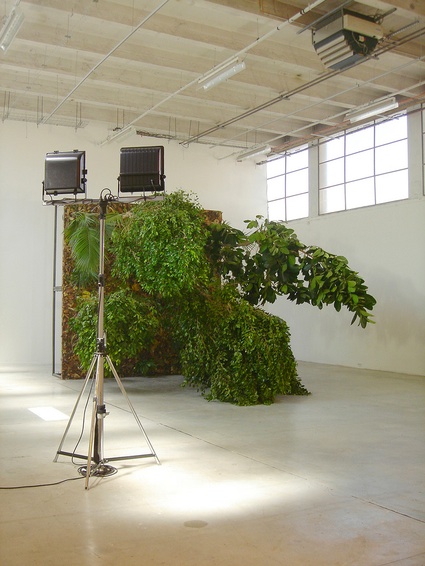 Henrik Håkansson, Fallen Forest, 2006. Courtesy the artist, Galleria Franco Noero, Turin and The Modern Institute/ Toby Webster Ltd, Glasgow. Photo: Yann Revol
Henrik Håkansson, Fallen Forest, 2006. Courtesy the artist, Galleria Franco Noero, Turin and The Modern Institute/ Toby Webster Ltd, Glasgow. Photo: Yann Revol
Henrik Hakansson displaced nature too but in a much more shocking way. His Fallen Forest is a 16-metre-square segment of rainforest re-planted in black plastic pots and flipped on its side as a comment on the unbalanced relationship between man and nature. Powerful lights pointed towards this portion of nature enable the plants to grow horizontally, though some of them didn’t seem to be in excellent shape when i visited the show.
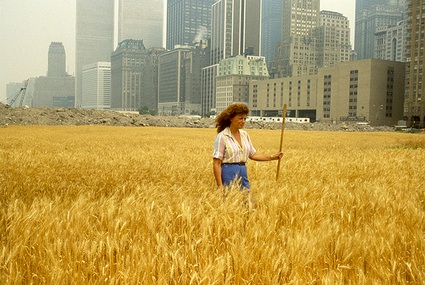 Agnes Denes. Wheatfield, A Confrontation, 1982. Photograph: © Agnes Denes
Agnes Denes. Wheatfield, A Confrontation, 1982. Photograph: © Agnes Denes
Courtesy the artist
In 1982, Agnes Denes planted a two-acre field of wheat in a vacant lot in downtown Manhattan. Wheatfield — A Confrontation yielded 1,000 lbs. of wheat on a ground worth fortunes to comment on “human values and misplaced priorities”.
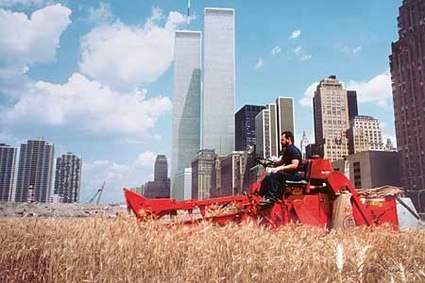
em>Agnes Denes. Wheatfield, A Confrontation, 1982. Photograph: © Agnes Denes
Courtesy the artist
It took her about a year to prepare the site, removing junk and debris from the construction of the nearby World Trade Center. She even installed an irrigation system. After that, trucks after trucks brought in organic matter to make the topsoil. The harvested grain then traveled to 28 cities worldwide and was symbolically planted around the globe.
As part of Radical Nature the work is restaged at an abandoned railway line in Dalston, East London (opens on July 15.)
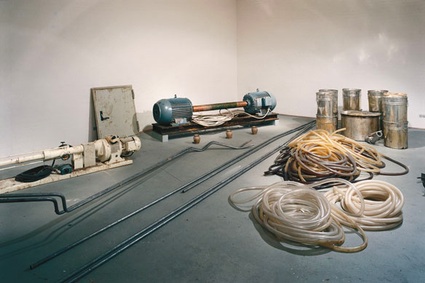 Joseph Beuys’s Honigpumpe am Arbeitsplatz (Honey Pump at the Workplace), 1977
Joseph Beuys’s Honigpumpe am Arbeitsplatz (Honey Pump at the Workplace), 1977
Photograph: Louisiana Museum of Modern Art, Denmark
One cannot dream of a more suitable guest at the exhibition than the co-founder of Germany’s Green Party. Barbican is indeed showing the remains of Honeypump in the Workplace, a performance that saw Joseph Beuys pumping two tons of honey through 17 meters of plastic tubing, using motors lubricated with over 200 pounds of margarine. The action lasted for the 100 days of Documenta 6 and was accompanied by talks and debates that all together highlighted his expanded notion of art.
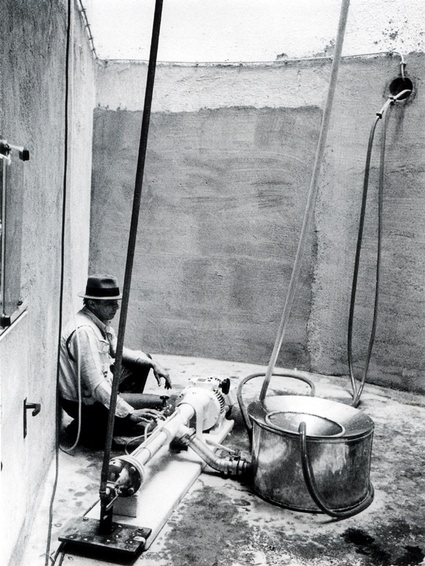 Joseph Beuys, Honigpumpe am Arbeitsplatz. First presented at documenta 6, 1977
Joseph Beuys, Honigpumpe am Arbeitsplatz. First presented at documenta 6, 1977
Honey takes an important place in Beuys’ work, it is the product of bees who, for him, represented as ideal society of warmth and collaboration.
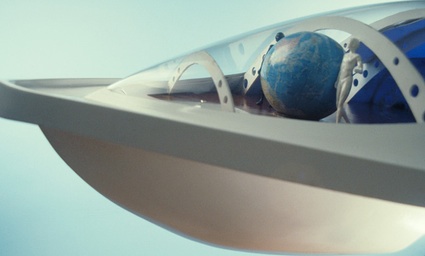 Ant Farm, Oceania, Dolphin Embassy Sea Craft, 1976. Photo: Doug Michels
Ant Farm, Oceania, Dolphin Embassy Sea Craft, 1976. Photo: Doug Michels
The Dolphin Embassy was an unrealized sea station that American architects Ant Farm had imagined to build in Australia. The project aimed at researching the possibility of establishing non-verbal communication between dolphins and humans using the new video technologies. Interspecies communication was for them a means to reach a shared vision for a harmonious co-evolution.
As usual, Ant Farm’s practice made an innovative use of technology, this time by making video equipment the intermediary that would enable humans to connect with dolphins. (more info at this video of a press conference where Doug Michels and Doug Hurr are presenting the Dolfin Embassy to the media.)
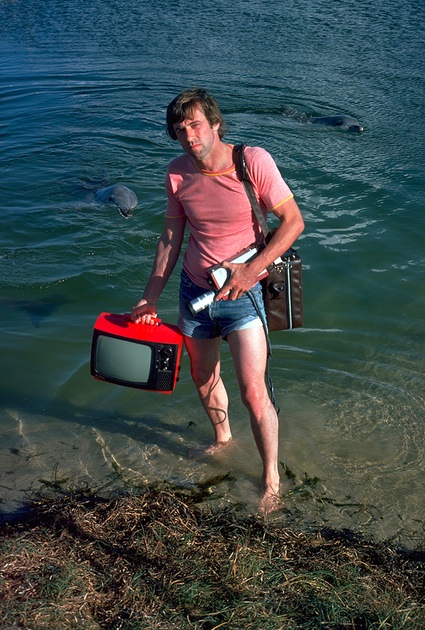 Ant Farm, Doug Michels with video and dolphins in Australia, 1977. Courtesy Ant Farm. Photo: Alex Morphett
Ant Farm, Doug Michels with video and dolphins in Australia, 1977. Courtesy Ant Farm. Photo: Alex Morphett
In the ’70s, Wolf Hilbertz developed the mineral accretion process which consists in the electrolytic deposition of sea-shell-like minerals from seawater that creates a construction material. Sunlight would then turn the minerals in seawater into limestone for underwater and dryland constructions.
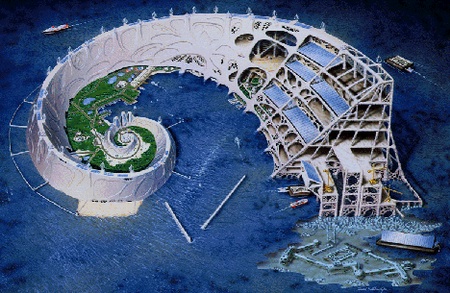
Hilbertz’s Autopia Ampere project was an island that would grow in the Mediterranean Sea. It would house, feed, and employ 50,000 inhabitants.
No one does Philippe Rahm like Philippe Rahm. His Pulmonary Space is a form made to inflate when 5 musicians blow into their wind instrument. In his statement about Pulmonary Space, Rahm refers to Hegel who considered music the most beautiful art form and architecture the lowest art form. According to the philosopher, the more an art form goes beyond its materiality, the less it is constrained by the natural world and the closest it is to pure spirit, the more elevated and transcendent it became.
Today we know that sound or voice are not abstract nor dematerialized. They possess a physical, biological and chemical dimension. Pulmonary Space gives a visible, physical presence to music.
Video of a Pulmonary Space performance:
Pulmonary space
More images: Barbican, flickr and The Guardian.
Radical Nature – Art and Architecture for a Changing Planet 1969-2009 runs until 18 October 2009 at the Barbican Art Gallery.
Events focusing on a similar topic: Day 1 at the VivoArts School for Transgenic Aesthetics: Seed broadcasting workshop, Open Sailing, drifting lifestyle to cope with looming disasters, How to Save the World in 10 Days at Vooruit in Ghent, Transmediale 09 – Survival and Utopia, Interview with Ulla Taipale from Capsula, Greenwashing. Environment, Perils, Promises and Perplexities , Ecological Strategies in Today’s Art (part 1) and (part 2).
See also: Ant Farm retrospective in Sevilla.

